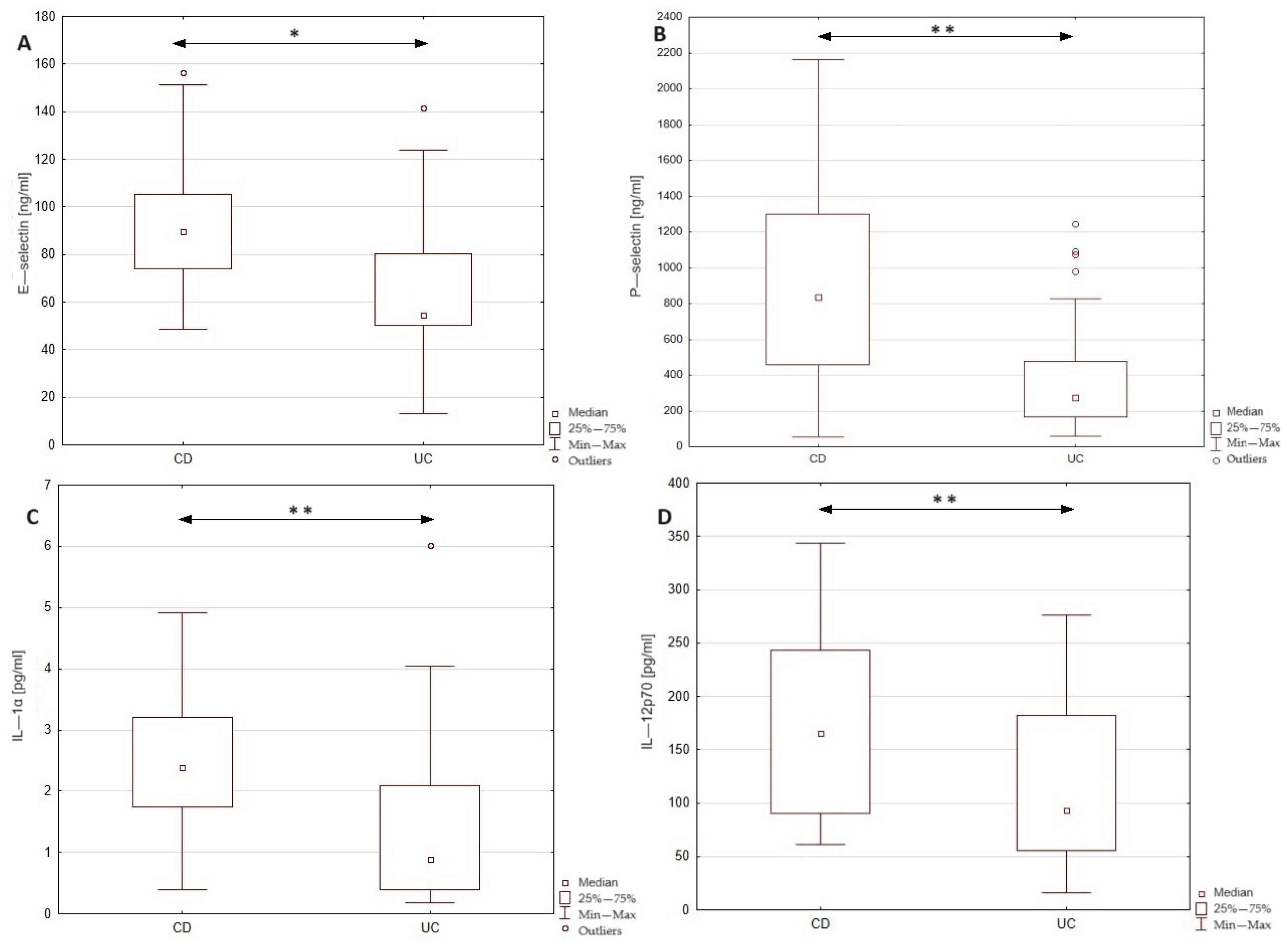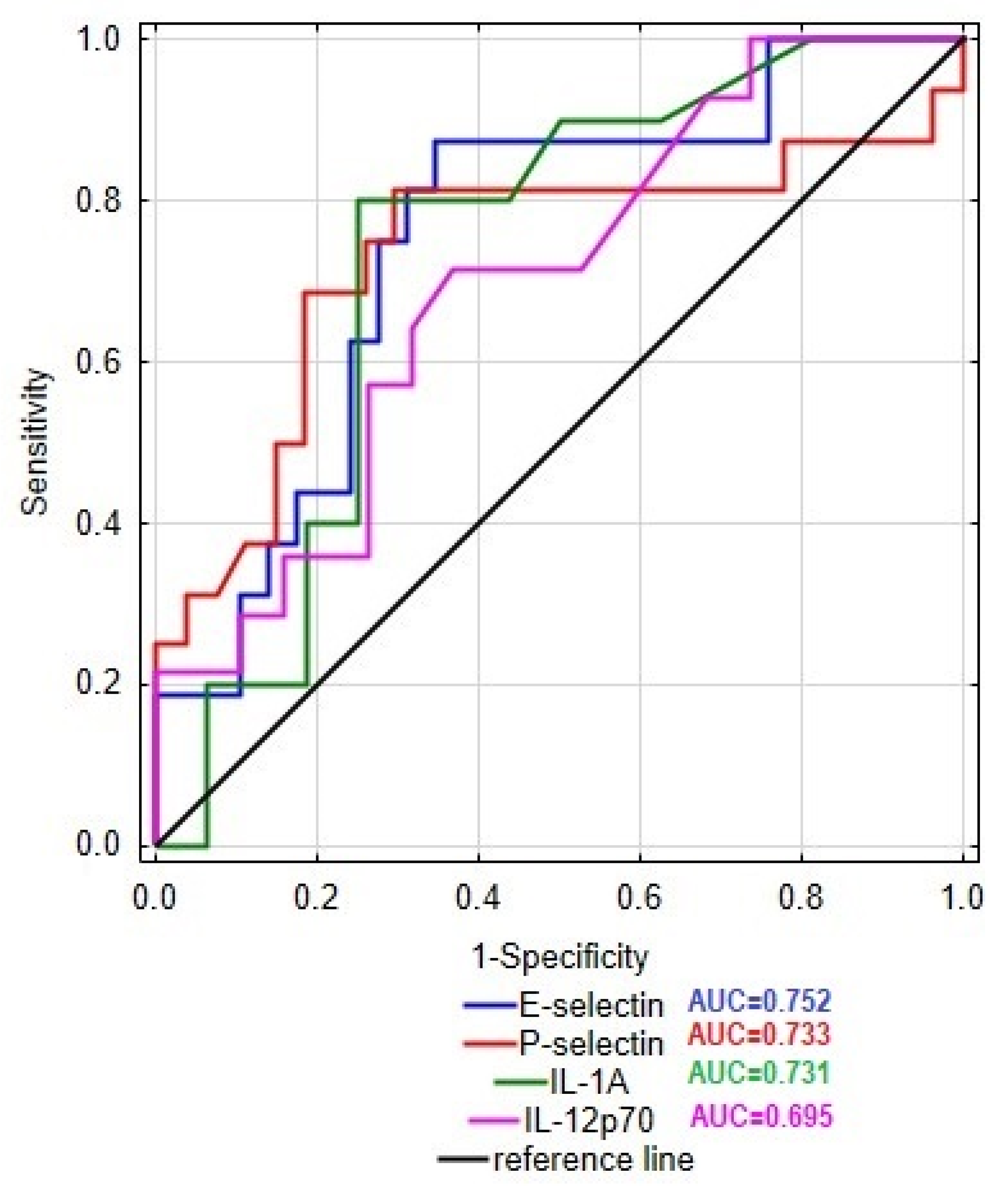Serum Profiling of Proinflammatory Mediators in Inflammatory Bowel Disease: Indication for Use in Differential Diagnosis
Abstract
:Featured Application
Abstract
1. Introduction
2. Materials and Methods
2.1. Study Population
2.2. Methods
2.3. Statistical Analyses
3. Results
3.1. Patients Characteristics
3.2. Comparison of Serum Proinflammatory Mediators Level between Patients with Crohn’s Disease and Ulcerative Colitis
3.3. Relationship between Profile of Proinflammatory Mediators and Disease Activity
3.4. Interrelationship between Analyzed Proinflammatory Mediators in Patients with Crohn’s Disease and Ulcerative Colitis
4. Discussion
4.1. Comparison of Serum Proinflammatory Mediators Level between Patients with Crohn’s Disease and Ulcerative Colitis
4.2. Relationship between Profile of Proinflammatory Mediators and Disease Activity
4.3. Interrelationship between Analyzed Proinflammatory Mediators in Patients with Crohn’s Disease and Ulcerative Colitis
5. Conclusions
Author Contributions
Funding
Institutional Review Board Statement
Informed Consent Statement
Data Availability Statement
Conflicts of Interest
References
- Flynn, S.; Eisenstein, S. Inflammatory Bowel Disease Presentation and Diagnosis. Surg. Clin. N. Am. 2019, 99, 1051–1062. [Google Scholar] [CrossRef] [PubMed]
- Le Berre, C.; Ananthakrishnan, A.N.; Danese, S.; Singh, S.; Peyrin-Biroulet, L. Ulcerative Colitis and Crohn’s Disease Have Similar Burden and Goals for Treatment. Clin. Gastroenterol. Hepatol. 2020, 18, 14–23. [Google Scholar] [CrossRef] [PubMed]
- Feakins, R.M. Ulcerative colitis or Crohn’s disease? Pitfalls and problems. Histopathology 2014, 64, 317–335. [Google Scholar] [CrossRef] [PubMed]
- Ramos, G.P.; Faubion, W.A.; Papadakis, K.A. Targeting Specific Immunologic Pathways in Crohn’s Disease. Gastroenterol. Clin. N. Am. 2017, 46, 577–588. [Google Scholar] [CrossRef] [PubMed]
- Gomez-Bris, R.; Saez, A.; Herrero-Fernandez, B.; Rius, C.; Sanchez-Martinez, H.; Gonzalez-Granado, J.M. CD4 T-Cell Subsets and the Pathophysiology of Inflammatory Bowel Disease. Int. J. Mol. Sci. 2023, 24, 2696. [Google Scholar] [CrossRef] [PubMed]
- Nakase, H.; Sato, N.; Mizuno, N.; Ikawa, Y. The influence of cytokines on the complex pathology of ulcerative colitis. Autoimmun Rev. 2022, 21, 103017. [Google Scholar] [CrossRef]
- Zelová, H.; Hošek, J. TNF-α signalling and inflammation: Interactions between old acquaintances. Inflamm. Res. 2013, 62, 641–651. [Google Scholar] [CrossRef] [PubMed]
- Ott, A.; Tutdibi, E.; Goedicke-Fritz, S.; Schöpe, J.; Zemlin, M.; Nourkami-Tutdibi, N. Serum cytokines MCP-1 and GCS-F as potential biomarkers in pediatric inflammatory bowel disease. PLoS ONE 2023, 18, e0288147. [Google Scholar] [CrossRef]
- Gu, L.; Tseng, S.; Horner, R.M.; Tam, C.; Loda, M.; Rollins, B.J. Control of TH2 polarization by the chemokine monocyte chemoattractant protein-1. Nature 2000, 404, 407–411. [Google Scholar] [CrossRef]
- Pooley, N.; Ghosh, L.; Sharon, P. Up-regulation of E-selectin and intercellular adhesion molecule-1 differs between Crohn’s disease and ulcerative colitis. Dig. Dis. Sci. 1995, 40, 219–225. [Google Scholar] [CrossRef]
- Magro, F.; Araujo, F.; Pereira, P.; Meireles, E.; Diniz-Ribeiro, M.; Velosom, F.T. Soluble selectins, sICAM, sVCAM, and angiogenic proteins in different activity groups of patients with inflammatory bowel disease. Dig. Dis. Sci. 2004, 49, 1265–1274. [Google Scholar] [CrossRef]
- Polek, A.; Sobiczewski, W.; Matowicka-Karna, J. P-selektyna i jej rola w niektórych chorobach. PHMD 2009, 63, 465–470. [Google Scholar] [PubMed]
- Cavalli, G.; Colafrancesco, S.; Emmi, G.; Imazio, M.; Lopalco, G.; Maggio, M.C.; Sota, J.; Dinarello, C.A. Interleukin 1α: A comprehensive review on the role of IL-1α in the pathogenesis and treatment of autoimmune and inflammatory diseases. Autoimmun. Rev. 2021, 20, 102763. [Google Scholar] [CrossRef]
- Schunk, S.J.; Triem, S.; Schmit, D.; Zewinger, S.; Sarakpi, T.; Becker, E.; Hütter, G.; Wrublewsky, S.; Küting, F.; Hohl, M.; et al. Interleukin-1α Is a Central Regulator of Leukocyte-Endothelial Adhesion in Myocardial Infarction and in Chronic Kidney Disease. Circulation 2021, 144, 893–908. [Google Scholar] [CrossRef]
- Komosinska-Vassev, K.; Kałużna, K.; Jura-Półtorak, A.; Derkacz, A.; Olczyk, K. Circulating Profile of ECM-Related Proteins as Diagnostic Markers in Inflammatory Bowel Diseases. J. Clin. Med. 2022, 11, 5618. [Google Scholar] [CrossRef]
- Lahiff, C.; Safaie, P.; Awais, A.; Akbari, M.; Gashin, L.; Sheth, S.; Lembo, A.; Leffler, D.; Moss, A.C.; Cheifetz, A.S. The Crohn’s disease activity index (CDAI) is similarly elevated in patients with Crohn’s disease and in patients with irritable bowel syndrome. Aliment. Pharmacol. Ther. 2013, 37, 786–794. [Google Scholar] [CrossRef]
- Ikeya, K.; Hanai, H.; Sugimoto, K.; Osawa, S.; Kawasaki, S.; Iida, T.; Maruyama, Y.; Watanabe, F. The Ulcerative Colitis Endoscopic Index of Severity More Accurately Reflects Clinical Outcomes and Long-term Prognosis than the Mayo Endoscopic Score. J. Crohn’s Colitis 2016, 10, 286–295. [Google Scholar] [CrossRef]
- Moschen, A.R.; Tilg, H.; Raine, T. IL-12, IL-23 and IL-17 in IBD: Immunobiology and therapeutic targeting. Nat. Rev. Gastroenterol. Hepatol. 2019, 16, 185–196. [Google Scholar] [CrossRef] [PubMed]
- Monteleone, G.; Biancone, L.; Marasco, R.; Morrone, G.; Marasco, O.; Luzza, F.; Pallone, F. Interleukin 12 is expressed and actively released by Crohn’s disease intestinal lamina propria mononuclear cells. Gastroenterology 1997, 112, 1169–1178. [Google Scholar] [CrossRef] [PubMed]
- Lazaridis, L.D.; Pistiki, A.; Giamarellos-Bourboulis, E.J.; Georgitsi, M.; Damoraki, G.; Polymeros, D.; Dimitriadis, G.D.; Triantafyllou, K. Activation of NLRP3 Inflammasome in Inflammatory Bowel Disease: Differences Between Crohn’s Disease and Ulcerative Colitis. Dig. Dis. Sci. 2017, 62, 2348–2356. [Google Scholar] [CrossRef]
- Malik, A.; Kanneganti, T.D. Function and regulation of IL-1α in inflammatory diseases and cancer. Immunol. Rev. 2018, 281, 124–137. [Google Scholar] [CrossRef] [PubMed]
- Voudoukis, E.; Karmiris, K.; Koutroubakis, I.E. Multipotent role of platelets in inflammatory bowel diseases: A clinical approach. World J. Gastroenterol. 2014, 20, 3180–3190. [Google Scholar] [CrossRef] [PubMed]
- Magnusson, M.K.; Strid, H.; Isaksson, S.; Bajor, A.; Lasson, A.; Ung, K.A.; Öhman, L. Response to infliximab therapy in ulcerative colitis is associated with decreased monocyte activation, reduced CCL2 expression and downregulation of Tenascin C. J. Crohn’s Colitis. 2015, 9, 56–65. [Google Scholar] [CrossRef] [PubMed]
- Sands, B.E.; Kaplan, G.G. The role of TNFα in ulcerative colitis. J. Clin. Pharmacol. 2007, 47, 930–941. [Google Scholar] [CrossRef] [PubMed]
- Dinallo, V.; Marafini, I.; Di Fusco, D.; Laudisi, F.; Franzè, E.; Di Grazia, A.; Figliuzzi, M.M.; Caprioli, F.; Stolfi, C.; Monteleone, I.; et al. Neutrophil Extracellular Traps Sustain Inflammatory Signals in Ulcerative Colitis. J. Crohn’s Colitis 2019, 13, 772–784. [Google Scholar] [CrossRef]
- Davies, J.M.; Radford, K.J.; Begun, J.; Levesque, J.P.; Winkler, I.G. Adhesion to E-selectin primes macrophages for activation through AKT and mTOR. Immunol. Cell Biol. 2021, 99, 622–639. [Google Scholar] [CrossRef]
- Ríos-Navarro, C.; de Pablo, C.; Collado-Diaz, V.; Orden, S.; Blas-Garcia, A.; Martínez-Cuesta, M.Á.; Esplugues, J.V.; Alvarez, A. Differential effects of anti-TNF-α and anti-IL-12/23 agents on human leukocyte-endothelial cell interactions. Eur. J. Pharmacol. 2015, 765, 355–365. [Google Scholar] [CrossRef]
- Aomatsu, T.; Imaeda, H.; Takahashi, K.; Fujimoto, T.; Kasumi, E.; Yoden, A.; Tamai, H.; Fujiyama, Y.; Andoh, A. Tacrolimus (FK506) suppresses TNF-α-induced CCL2 (MCP-1) and CXCL10 (IP-10) expression via the inhibition of p38 MAP kinase activation in human colonic myofibroblasts. Int. J. Mol. Med. 2012, 30, 1152–1158. [Google Scholar] [CrossRef]
- McDaniel, D.K.; Eden, K.; Ringel, V.M.; Allen, I.C. Emerging Roles for Noncanonical NF-κB Signaling in the Modulation of Inflammatory Bowel Disease Pathobiology. Inflamm. Bowel. Dis. 2016, 22, 2265–2279. [Google Scholar] [CrossRef]
- Turner, N.A.; Das, A.; Warburton, P.; O’Regan, D.J.; Ball, S.G.; Porter, K.E. Interleukin-1α stimulates proinflammatory cytokine expression in human cardiac myofibroblasts. Am. J. Physiol. Heart Circ. Physiol. 2009, 297, H1117-27. [Google Scholar] [CrossRef]
- Coskun, M.; Olsen, J.; Seidelin, J.B.; Nielsen, O.H. MAP kinases in inflammatory bowel disease. Clin. Chim. Acta 2011, 412, 513–520. [Google Scholar] [CrossRef] [PubMed]


| Patients with Crohn’s Disease | Patients with Ulcerative Colitis | |
|---|---|---|
| Age [years] | 32.10 ± 9.56 | 33.38 ± 12.75 |
| Sex | 7 females, 9 males | 12 females, 18 males |
| Activity of the disease | CDAI score: 307.3 ± 53.7 | Mayo endoscopic score: 2.6 ± 0.5 |
| CRP [mg/L] | 18.8 ± 20.1 | 14.4 ± 24.5 |
| Serum calprotectin [ng/mL] | 3537.5 ± 1893.8 | 3337.1 ± 1775.3 |
| Platelets [×109/L] | 326.7 ± 59.9 | 382.4 ± 24.5 |
| Hemoglobin [g/dL] | 12.9 ± 2.3 | 11.5 ± 2.4 |
| Potassium [mmol/L] | 4.2 ± 0.4 | 4.16 ± 0.4 |
| Sodium [mmol/L] | 138.1 ± 2.8 | 140.0 ± 1.9 |
| Glucose [mg/dL] | 86.7 ± 8.3 | 89.6 ± 12.8 |
| Creatinine [mg/dL] | 0.9 ± 0.2 | 0.9 ± 0.1 |
| BMI [kg/m2] | 20.58 ± 3.43 | 24.25 ± 3.59 |
| The Activity of the Disease in Patients with Crohn’s Disease (CDAI Score) | The Activity of the Disease in Patients with Ulcerative Colitis (Mayo Endoscopic Score) | |
|---|---|---|
| E-selectin [ng/mL] | p > 0.05 | p > 0.05 |
| p-selectin [ng/mL] | p > 0.05 | p > 0.05 |
| CCL-2 (MCP-1) [pg/mL] | p > 0.05 | r = 0.566, p < 0.005 |
| IL-1α [pg/mL] | p > 0.05 | p > 0.05 |
| IL-12p70 [pg/mL] | p > 0.05 | p > 0.05 |
| TNF-α [pg/mL] | p > 0.05 | r = 0.431, p < 0.05 |
| E-Selectin | P-Selectin | CCL-2 (MCP-1) | IL-1α | |
|---|---|---|---|---|
| IL-1α | p > 0.05 | r = 0.514; p < 0.05 | p > 0.05 | |
| IL-12p70 | r = 0.542, p < 0.05 | p > 0.05 | p > 0.05 | p > 0.05 |
| TNF-α | r = 0.372; p < 0.05 | p > 0.05 | r = 0.550; p < 0.05 | r = 0.637; p < 0.005 |
Disclaimer/Publisher’s Note: The statements, opinions and data contained in all publications are solely those of the individual author(s) and contributor(s) and not of MDPI and/or the editor(s). MDPI and/or the editor(s) disclaim responsibility for any injury to people or property resulting from any ideas, methods, instructions or products referred to in the content. |
© 2024 by the authors. Licensee MDPI, Basel, Switzerland. This article is an open access article distributed under the terms and conditions of the Creative Commons Attribution (CC BY) license (https://creativecommons.org/licenses/by/4.0/).
Share and Cite
Górecka, A.; Wisowski, G.; Kisselova-Kaneva, Y.; Ivanova, D.; Olczyk, P.; Komosinska-Vassev, K. Serum Profiling of Proinflammatory Mediators in Inflammatory Bowel Disease: Indication for Use in Differential Diagnosis. Appl. Sci. 2024, 14, 5434. https://doi.org/10.3390/app14135434
Górecka A, Wisowski G, Kisselova-Kaneva Y, Ivanova D, Olczyk P, Komosinska-Vassev K. Serum Profiling of Proinflammatory Mediators in Inflammatory Bowel Disease: Indication for Use in Differential Diagnosis. Applied Sciences. 2024; 14(13):5434. https://doi.org/10.3390/app14135434
Chicago/Turabian StyleGórecka, Aleksandra, Grzegorz Wisowski, Yoana Kisselova-Kaneva, Diana Ivanova, Paweł Olczyk, and Katarzyna Komosinska-Vassev. 2024. "Serum Profiling of Proinflammatory Mediators in Inflammatory Bowel Disease: Indication for Use in Differential Diagnosis" Applied Sciences 14, no. 13: 5434. https://doi.org/10.3390/app14135434





